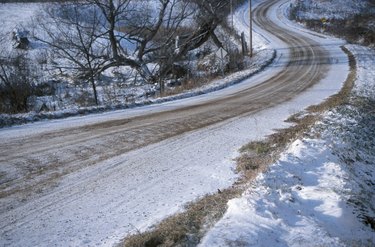
Winter snow on walkways and stairs poses a danger to anyone who sets foot on your property. It's a good idea to remove snow and ice to prevent slippery conditions, but deicers have the unwanted side effect of damaging grass and shrubs that border your walkways. Luckily, there are some things you can do to minimize the damage that deicers do to your lawn, and there are some alternatives to deicers altogether.
Chemical Deicing Options
Video of the Day
According to the University of Nebraska, sodium chloride, or common rock salt, does the most damage to grass and other vegetation. Salt burns leaves that it comes in direct contact with and causes chemical drought by decreasing the quantity of available water in the soil.
Video of the Day
Magnesium chloride and calcium chloride are less hazardous to plant life, but they are just as corrosive and will rust metal and flake concrete. They are also especially hard on floors and carpets, making them impractical for everyday winter use.
Potassium chloride, which still poses a moderate risk to your lawn, works only in temperatures above 25 degrees F, so those who experience harsh winters will find it useless.
Addressing Salt Damage
Once salt damage has occurred, treat your lawn by deep watering it three or four times in the spring, according to Maryland Cooperative Extension. This will flush out extra sodium in the soil. If a large amount of rock salt has come in contact with your lawn, add gypsum to the soil to reduce the sodium level.
If you cannot repair the damage to your lawn, sod or seed the damaged areas. New grass won't grow in soil with high sodium levels, so you must address the soil condition before planting.
Alternatives to Salt
Although salt may be best at melting snow and ice, there are alternatives that are safer for your lawn and can still improve the safety of winter walkways. Sprinkle an abrasive such as sand or cinders on sidewalks to improve traction. The downside to abrasives is that you will track them into your home and will need to sweep them off your driveway once the snow melts.
Another option is to sprinkle a dark-colored material on the snow to help it melt faster. Ash or a dark-colored granule fertilizer will absorb the sun's radiation and transfer heat to the snow, making it melt. This method can also lead to messy floors, and you will need to reapply the dark matter with each new snowfall.
Considerations
Minimize the need for deicers by manually removing as much snow and ice as possible. When shoveling or plowing, do not pile snow from salted areas onto plants. Once you remove snow and ice, use only as much deicer as you really need.
Ask your landscaper to help you choose salt-tolerant plants. When possible, cover shrubs and plants that are near paved areas with burlap to protect them from salt spray in the winter.
- University of Nebraska – Lincoln: Turf iNfo for the North Central US -- Deicing Agents: Pros and Cons
- Extension InfoNet; Lawn & Garden -- Salt Injury; Lynn Loughary
- Cornell University Cooperative Extension; “Lawn Care Without Pesticides”; Frank Rossi
- Cornell University: Home Gardening -- Salt Damage
- University of Florida: Gardening in a Minute -- Salt-Tolerant Lawn Grasses
- Michigan State University Dept. of Crop and Soil Sciences; Winter Deicing Salts…; Paul E. Rieke